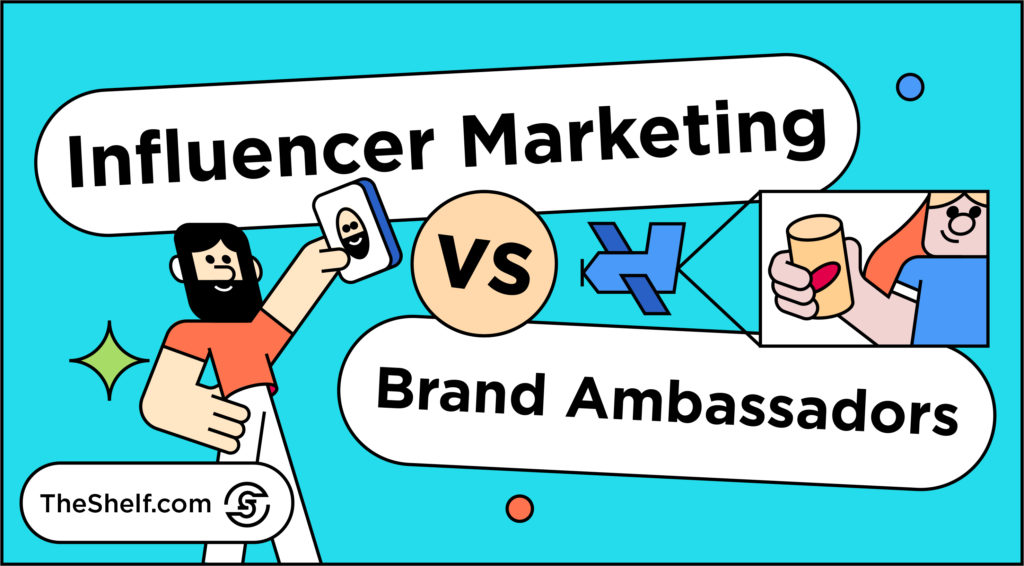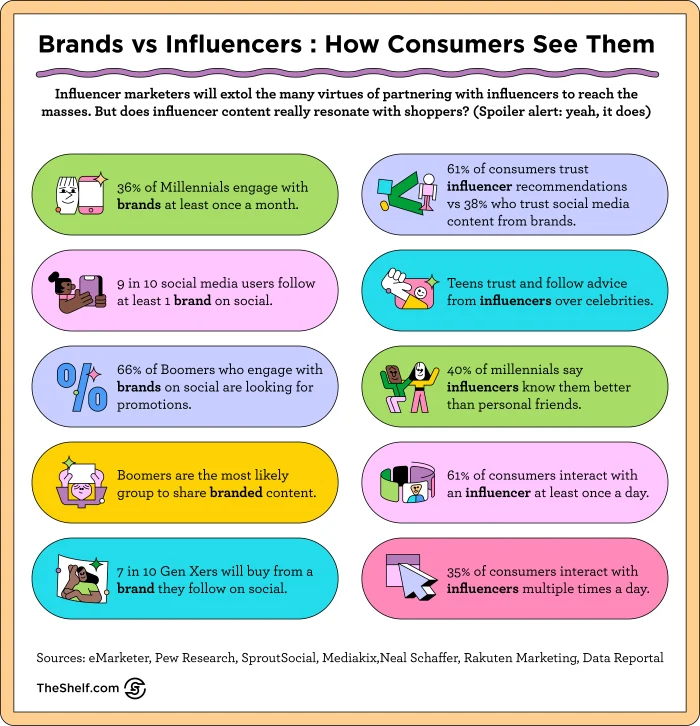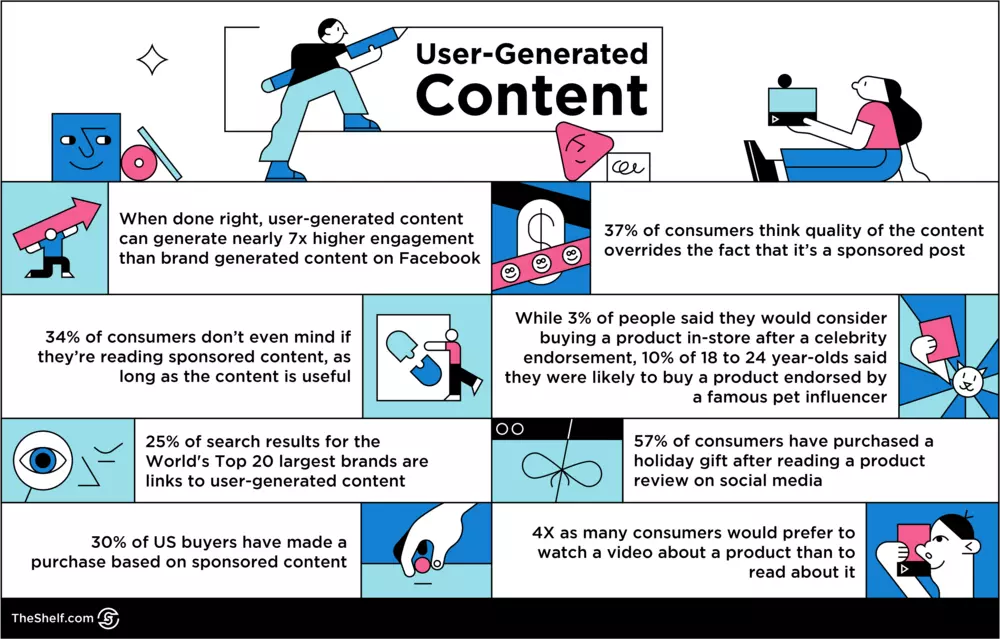If you’re like most businesses, you’ve realized that online relevance is the only way to survive the information age. As you look for new ways to reach more customers and build your brand, you may have come across the terms “brand ambassador” and “influencer” and wonder if they’re different. Yes, they are. Cool. So… Influencer Marketing vs brand ambassador: which one is right for your business?
Keep reading! We’ll cover the ins and outs of the brand ambassador vs influencer marketing debate.
So, what is the difference between an influencer and a brand ambassador? First things first. To understand the differences between brand ambassadors and influencers, we first need to understand what they are.

What is a Brand Ambassador?
A brand ambassador is someone who agrees to represent your company and promote your products or services to their social media followers. The most valuable brand ambassadors already love your product, your brand, and your whole vibe… and they’re typically pretty influential and well-connected. Think in terms of bloggers, social media personalities, or celebrities. They make fantastic brand advocates.
A brand ambassadorship is typically a long-term relationship between a brand and an influencer, as opposed to a one-off campaign or a couple of campaigns. The ambassador may be paid, receive FREE products as compensation, or both.
Now, this isn’t a situation where some random e-comm weirdo DMs a teenager and says, “If you buy three pairs of our expensive leggings, you can be a brand ambassador and get allll the rest of our expensive leggings 30% off.” That’s a friggin’ coupon code, not an ambassadorship (we get really annoyed at fake ambassador programs).
Usually, brand ambassadors have a different payment structure than influencers. Instead of being paid for posting a single piece of content, they receive compensation each time someone uses your link or code to buy something from the company. Meaning, ambassadors get ongoing compensation for their ongoing services.
One of the key benefits brands enjoy when working with brand ambassadors is that these ambassadors will already have an established relationship with their audience. This means that when creators promote your products and services, their followers are more likely to listen and take action. Additionally, because brand ambassadors are typically industry experts or thought leaders, their endorsements can go a long way in building trust and credibility for your business.
Now, let’s just circle back to the fake ambassador program situation. The victims of these scams are being convinced that by buying and wearing a certain brand’s clothing, they will be considered for the position of official brand ambassador. The only perk to this “job” is that the teens get to keep the clothes they were “gifted”….except they bought these items. 🤦🏽♀️
The “employer” in this case is usually a scam artist, looking to make a quick buck by selling clothes to unsuspecting teens. The best way to protect yourself and loved ones from these types of scams is to be aware of them and do your research before getting involved with any brand ambassador program.
What Is An Influencer?
An influencer, on the other hand, is anyone with the power to influence the actions (and especially the buying decisions) of others because of their authority, knowledge, position, or relationship. Social media users seek them out for their expertise.

Unlike brand ambassadors, who have a long-term relationship with a single company, influencers typically work with multiple brands and promote products as part of their regular content strategy. For example, a popular beauty blogger may feature a new skincare product in their monthly favorites video, or a travel influencer may mention a new luggage brand in their packing tips blog post.
Types of influencers
It may seem like everyone is calling themselves an influencer these days, but the group of creators who engage on social as influencers make up only 1 percent of social media users. We typically divide influencers into five types based on the sizes of their audiences: There are several types of influencers, the most common being: mega-influencers, macro-influencers, mid-tier influencers, micro-influencers, and nano-influencers.
- Mega Influencers – are often global brands themselves who have parlayed their offline celebrity into online influence (and vice versa). They typically have tens of millions of followers.
- Macro Influencers – have between 300,000 and 1,000,000 single-platform followers. Most macro-influencers are well-known internet stars, most of whom earned their fame online first, and gained their following by creating enticing content, usually across multiple social channels.
- Mid-tier influencers – Mid-tier influencers have between 50,000 and 300,000 single-platform followers. Weirdly, they aren’t always thought of when brands are doing influencer selection, even though they have sway with tens of thousands of social media users.
- Micro-Influencers – have single-platform audiences that range from 10,000 to 50,000 followers or so. Micros are the cool, up-and-coming social media stars that everyone wants to know and be friends with. Why? ‘Cause they’re cheap dates and know all the trivia. (Haha)
- Nano-Influencers – have between 1,000 and 10,000 or so followers. Very influential, highly engaged, and typically have a tight-knit community of followers. One caveat: nano-influencers are only classified as such if they actually have intentions of being one.
And Influencer Marketing Is…
Influencer marketing is one of the most effective forms of marketing, as it allows brands to tap into the networks of influencers to hyper-target their marketing to different segments of their target audiences. It’s so effective that 93 percent of marketers are currently using influencer marketing campaigns to grow brands.
The Right Influencers

Finding the ideal influencers for your campaign can be a challenge, but it’s important to take the time to find individuals who are genuinely interested in your products or services and who have an engaged following that matches/overlaps your target audience.
There are key indicators that must be in place if you want the perfect influencer for your campaign. Finding these alone can be daunting, but we’re here to help (our influencer discovery team is of the legendary variety). Here are a few non-negotiables that you should have in place.
- The influencer should be able to nudge your brand toward its marketing goal with each post. They should know your target audience and be inclusive of them.
- The influencer should have an engaged audience with a high level of followership in comparison to other social media users.
- The influencer should produce gorgeous, high-quality content that would be a good fit for your brand.
- You should see measurable success after working with the influencer, such as clicks, downloads, and a larger following.
Additionally, you’ll want to consider the overall type and aesthetic of an influencer’s content to ensure that it aligns with your brand. This is especially important if you’re targeting a specific demographic, such as millennial women.
Also, you want the influencer to have been vetted and researched to prevent brand safety issues. Looking at follower counts, engagement ratios and content is great, but you also want to ensure you look at their other channels, how frequently they’re posting, the types of comments/feedback they’re getting from their audience and how they’ve responded to their audience.
When in doubt, it’s always a good idea to start by looking at influencers who have worked with businesses similar to yours. This will give you a good sense of the type of content they produce and whether or not their followers might be interested in what your brand has to offer.
The Right Brand Ambassadors
Deciding to utilize the services of a brand ambassador is a huge marketing decision. After all, these are the people who will be tasked with representing your company in a positive light and helping to increase brand awareness and sales. But before you can start reaping the rewards of having a team of brand ambassadors on your side, you first need to make sure you’re choosing the right ones.
The best brand ambassadors are those who genuinely believe in your company and its products or services. They should be passionate about what they do, and their excitement should be contagious. Additionally, they should be knowledgeable about your brand and be able to speak confidently about it to others.
It’s also important to select brand ambassadors who are outgoing and have a loyal social media following. Ambassadors who can connect with potential customers and create a rapport are more likely to be successful in their efforts. And of course, you’ll want to make sure your ambassadors are good at promoting specials, discounts, and other promotional offers from your company.
Choosing the right brand ambassadors is the secret to the success of your marketing efforts. By taking the time to select ambassadors who truly believe in your brand and are excited about promoting it, you’ll be well on your way to achieving your marketing goals.
Similarities Between Brand Ambassador and Influencer Marketing Programs
While there are some key differences between brand ambassadors and influencers, there are also some important similarities. For example, both groups typically have large online audiences and can help you reach more potential customers for your business. Additionally, both brand ambassadors and influencers can help build trust and credibility for your business by endorsing your products or services.
Another thing the two have in common is that they both require a bit of time and effort to cultivate relationships. However, the rewards can be well worth it for your business. Repurposing the content created by influencers and brand ambassadors is a great way to populate your website, marketing emails, and paid ads with highly engaging, beautiful content. Something like 79 percent of consumers say UGC greatly persuade their purchasing decisions.
Differences Between Brand Ambassador and Influencer Marketing Programs
While brand ambassador and influencer marketing programs both have their benefits, there are also some key differences between the two approaches. Again, brand ambassadors typically have a longer-term relationship with your business and may be paid or receive products as compensation. Additionally, brand ambassadors are typically industry experts or thought leaders whose endorsement can help build trust and credibility for your business.
On the other hand, influencers tend to have even more social media followers than brand ambassadors and only promote products or services that they genuinely like or believe in. Additionally, because influencers carefully curate the content they share with their followers, they tend to have a very engaged audience. And finally, influencers often use multiple platforms to reach their audience—giving you even more exposure for your business.
Elements of a Great Brand Ambassador Campaign
Creating a brand ambassador (BA) campaign can feel daunting, but it doesn’t have to be. Here are a couple of key elements that will help make your BA campaign dope AF.
First, you need to identify your target audience. This is critical because you want to make sure you’re reaching the right people with your campaign. Once you know who your target audience is, you can begin to develop a strategy for reaching them.
Next, you need to create some goals for your campaign. What do you hope to achieve? Do you want to increase brand awareness? Drive sales? Boost engagement? Once you know your goals, messaging and content that resonates with your audience can be created and help you achieve those goals.
Finally, you need to choose the right platform for your campaign. There are a lot of options out there, so it’s important to pick the one that makes the most sense for your business. If you’re not sure where to start, consider using a social media platform like Instagram or Twitter.
Elements of A Magical Influencer Marketing Campaign
An Influencer Marketing campaign can be a very effective way to promote your brand or product. Nearly 9 in 10 marketers say influencer marketing is effective, but, as with any marketing campaign, there are tons of moving parts, but certain elements must be in place for it to be successful. Here are some steps that can help answer the most commonly asked questionsabout how we create our magical influencer marketing campaigns.
- A Clear Goal
The first step in creating a successful Influencer Marketing campaign is to have a clear goal. What are you trying to achieve with this campaign? Are you looking to increase brand awareness, drive traffic to your website, or generate sales? Once you know what your goal is, you can create content and strategies that are designed to achieve that specific goal.
- The Right Influencers
Not all influencers are created equal. It’s important to select influencers who are a good fit for your brand and who have a genuine interest in your products or services. Again, these influencers should also have an engaged following that is relevant to your target audience.
- Choose The Best Platform
There are several different social media platforms that you can use for your Influencer Marketing campaign, but it’s important to choose the one that will work best for you. If you’re trying to reach a younger audience, Tiktok or Instagram might be the best platforms.
How Can We Help?
So what have you decided? Which marketing strategy—brand ambassador or influencer marketing—is right for your business? Should you choose ambassadors or influencers? At our agency, we specialize in finding the ideal influencers for your business and developing creative campaigns that achieve your desired results.
It’s time to build your next micro-influencer marketing campaign. Book a call with The Shelf to learn how we make the process simple and effective. Our influencer marketing services can help you run campaigns shaped by data-driven insights.








